Abstract
For a cohort of 1189 male German former herbicide and insecticide workers with exposure to polychlorinated dibenzo-p-dioxins and -furans (PCDD/F), we report an extended standardized mortality ratio (SMR) analysis based on a new quantitative exposure index. This index characterizes the cumulative lifetime exposure by integrating the estimated concentration of PCDD/F at every point in time (area under the curve). Production department-specific dose rates were derived from blood levels and working histories of 275 workers by applying a first-order kinetic model. These dose rates were used to estimate exposure levels for all cohort members. Total mortality was elevated in the cohort; 413 deaths yielded an SMR of 1.15 (95% confidence interval [Cl] 1.05, 1.27) compared to the mortality of the population of Germany. Overall cancer mortality (n = 124) was significantly increased (SMR = 1.41, 95% Cl 1.17, 1.68). Various cancer sites showed significantly increased SMRs. The exposure index was used for an SMR analysis of total cancer mortality by dose. For 2,3,7,8-tetrachlorodibenzo-p-dioxin (TCDD) a significant trend (p = 0.01) for the SMRs with increasing cumulative PCDD/F exposure was observed. The SMR in the first exposure quartile (0-125.2 ng/kg x years) was 1.24 (95% Cl 0.82, 1.79), increasing to 1.73 (95% Cl 1.21, 2.40) in the last quartile (> or = 2503.0 ng/kg x years). For all congeners combined as toxic equivalencies (TEQ) using international toxic equivalency factors, a significant increase in cancer mortality was observed in the second quartile (360.9-1614.4 ng/kg x years, SMR 1.64; 95% Cl 1.13, 2.29) and the fourth quartile (> or = 5217.7 ng/kg x years TEQ, SMR 1.64, 95% Cl 1.13, 2.29). The trend test was not significant. The results justify the use of this cohort for a quantitative risk assessment for TCDD and to a lesser extent for TEQ.
Full text
PDF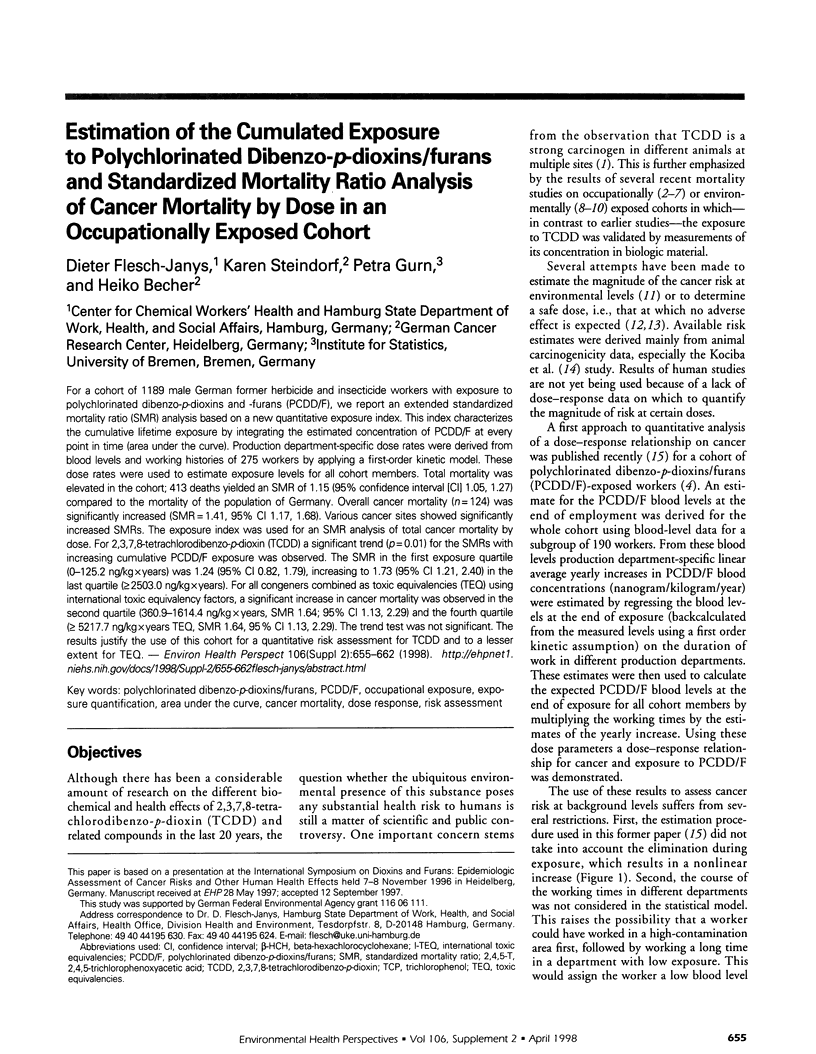

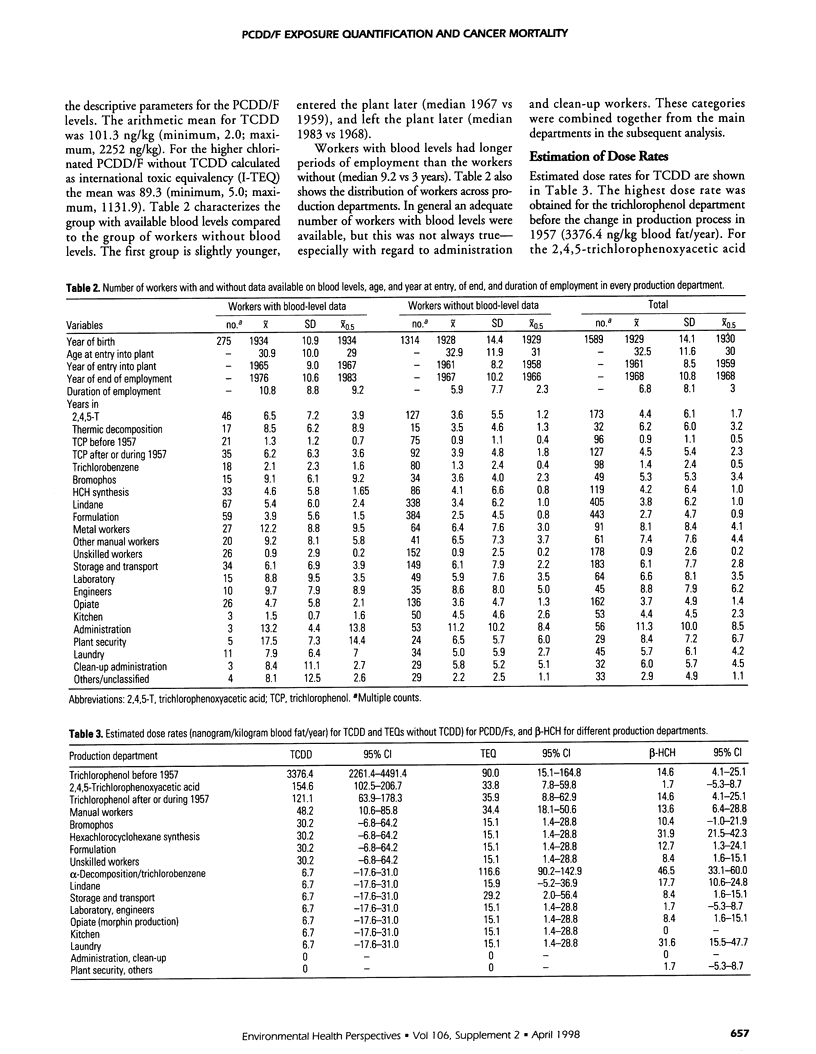

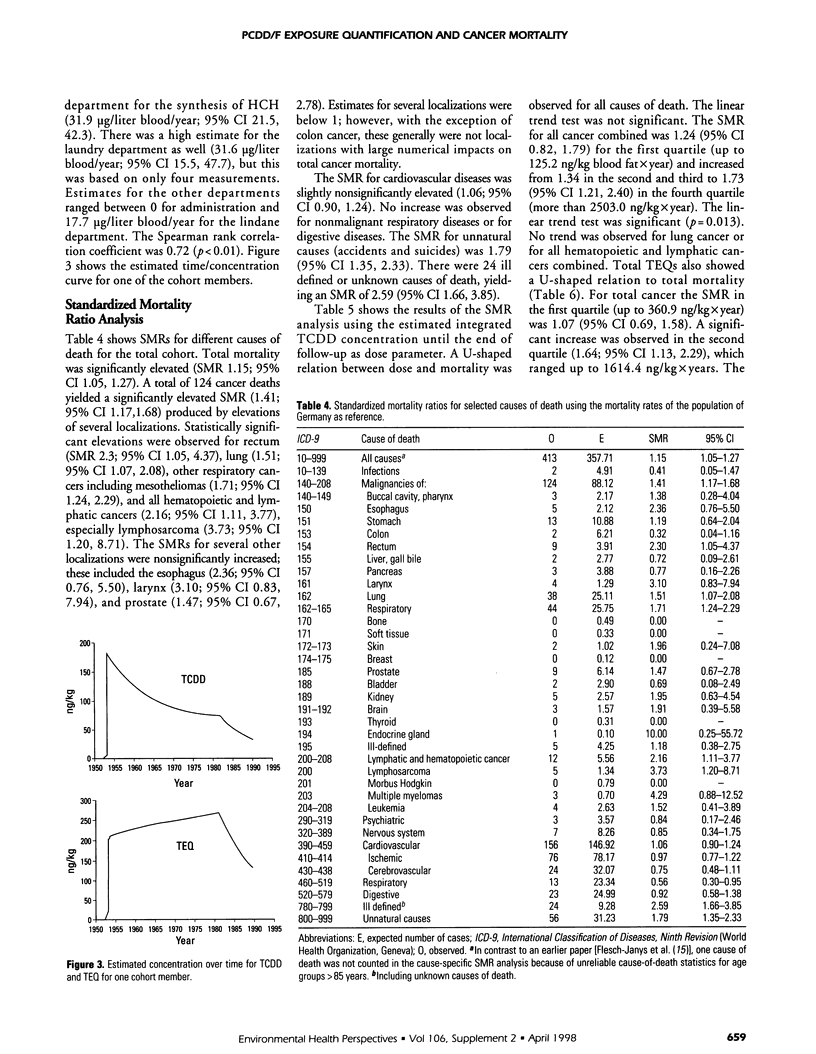

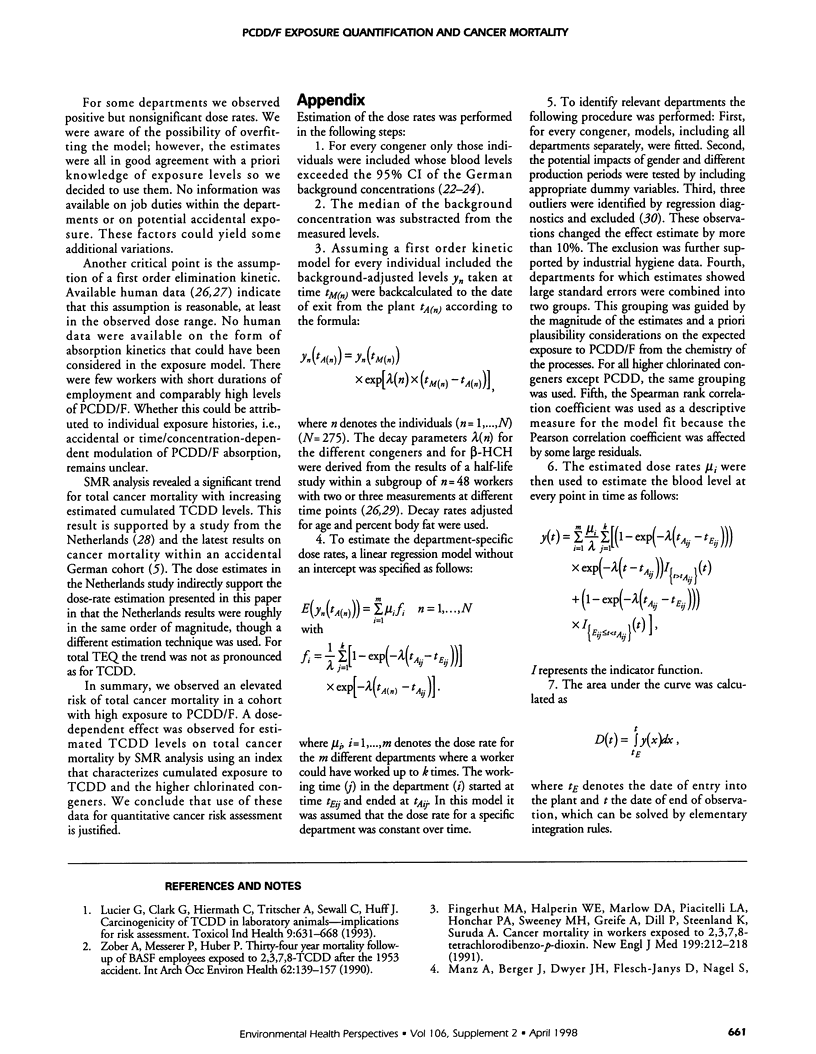
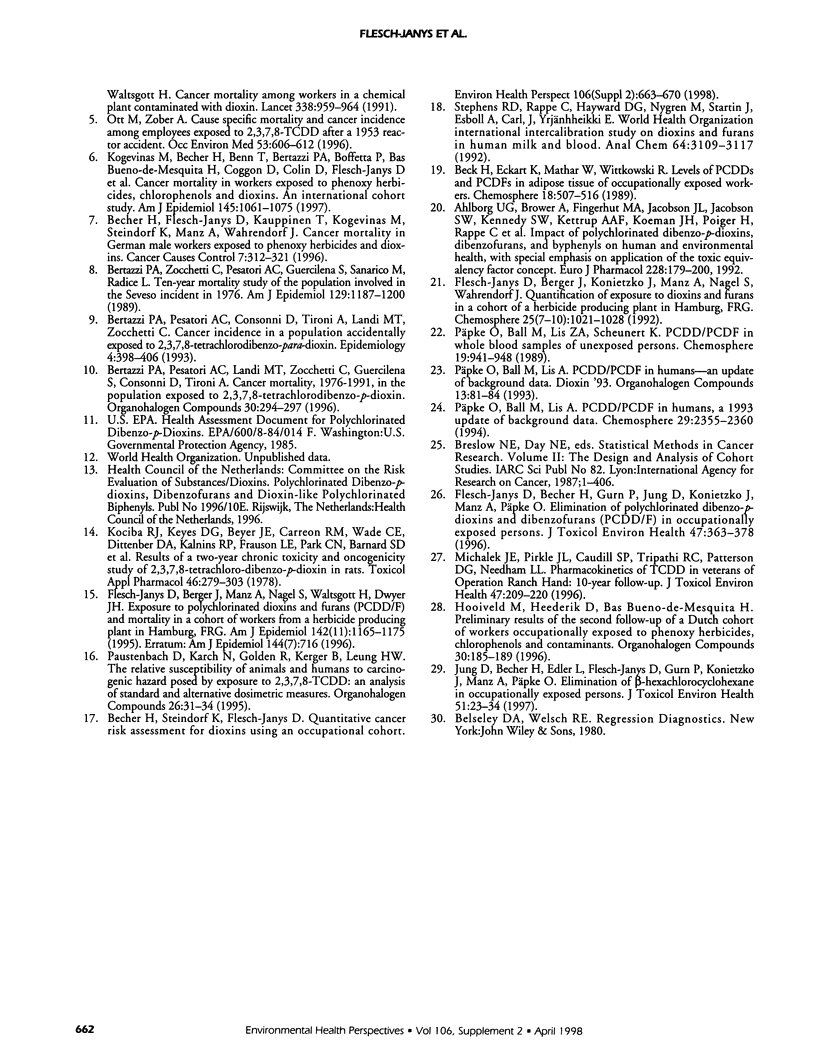
Images in this article
Selected References
These references are in PubMed. This may not be the complete list of references from this article.
- Ahlborg U. G., Brouwer A., Fingerhut M. A., Jacobson J. L., Jacobson S. W., Kennedy S. W., Kettrup A. A., Koeman J. H., Poiger H., Rappe C. Impact of polychlorinated dibenzo-p-dioxins, dibenzofurans, and biphenyls on human and environmental health, with special emphasis on application of the toxic equivalency factor concept. Eur J Pharmacol. 1992 Dec 1;228(4):179–199. doi: 10.1016/0926-6917(92)90029-c. [DOI] [PubMed] [Google Scholar]
- Becher H., Flesch-Janys D., Kauppinen T., Kogevinas M., Steindorf K., Manz A., Wahrendorf J. Cancer mortality in German male workers exposed to phenoxy herbicides and dioxins. Cancer Causes Control. 1996 May;7(3):312–321. doi: 10.1007/BF00052936. [DOI] [PubMed] [Google Scholar]
- Becher H., Steindorf K., Flesch-Janys D. Quantitative cancer risk assessment for dioxins using an occupational cohort. Environ Health Perspect. 1998 Apr;106 (Suppl 2):663–670. doi: 10.1289/ehp.98106663. [DOI] [PMC free article] [PubMed] [Google Scholar]
- Bertazzi A., Pesatori A. C., Consonni D., Tironi A., Landi M. T., Zocchetti C. Cancer incidence in a population accidentally exposed to 2,3,7,8-tetrachlorodibenzo-para-dioxin. Epidemiology. 1993 Sep;4(5):398–406. doi: 10.1097/00001648-199309000-00004. [DOI] [PubMed] [Google Scholar]
- Bertazzi P. A., Zocchetti C., Pesatori A. C., Guercilena S., Sanarico M., Radice L. Ten-year mortality study of the population involved in the Seveso incident in 1976. Am J Epidemiol. 1989 Jun;129(6):1187–1200. doi: 10.1093/oxfordjournals.aje.a115240. [DOI] [PubMed] [Google Scholar]
- Breslow N. E., Day N. E. Statistical methods in cancer research. Volume II--The design and analysis of cohort studies. IARC Sci Publ. 1987;(82):1–406. [PubMed] [Google Scholar]
- Fingerhut M. A., Halperin W. E., Marlow D. A., Piacitelli L. A., Honchar P. A., Sweeney M. H., Greife A. L., Dill P. A., Steenland K., Suruda A. J. Cancer mortality in workers exposed to 2,3,7,8-tetrachlorodibenzo-p-dioxin. N Engl J Med. 1991 Jan 24;324(4):212–218. doi: 10.1056/NEJM199101243240402. [DOI] [PubMed] [Google Scholar]
- Flesch-Janys D., Becher H., Gurn P., Jung D., Konietzko J., Manz A., Päpke O. Elimination of polychlorinated dibenzo-p-dioxins and dibenzofurans in occupationally exposed persons. J Toxicol Environ Health. 1996 Mar;47(4):363–378. doi: 10.1080/009841096161708. [DOI] [PubMed] [Google Scholar]
- Flesch-Janys D., Berger J., Gurn P., Manz A., Nagel S., Waltsgott H., Dwyer J. H. Exposure to polychlorinated dioxins and furans (PCDD/F) and mortality in a cohort of workers from a herbicide-producing plant in Hamburg, Federal Republic of Germany. Am J Epidemiol. 1995 Dec 1;142(11):1165–1175. doi: 10.1093/oxfordjournals.aje.a117575. [DOI] [PubMed] [Google Scholar]
- Jung D., Becher H., Edler L., Flesch-Janys D., Gurn P., Konietzko J., Manz A., Päpke O. Elimination of beta-hexachlorocyclohexane in occupationally exposed persons. J Toxicol Environ Health. 1997 May;51(1):23–34. doi: 10.1080/00984109708984009. [DOI] [PubMed] [Google Scholar]
- Kociba R. J., Keyes D. G., Beyer J. E., Carreon R. M., Wade C. E., Dittenber D. A., Kalnins R. P., Frauson L. E., Park C. N., Barnard S. D. Results of a two-year chronic toxicity and oncogenicity study of 2,3,7,8-tetrachlorodibenzo-p-dioxin in rats. Toxicol Appl Pharmacol. 1978 Nov;46(2):279–303. doi: 10.1016/0041-008x(78)90075-3. [DOI] [PubMed] [Google Scholar]
- Kogevinas M., Becher H., Benn T., Bertazzi P. A., Boffetta P., Bueno-de-Mesquita H. B., Coggon D., Colin D., Flesch-Janys D., Fingerhut M. Cancer mortality in workers exposed to phenoxy herbicides, chlorophenols, and dioxins. An expanded and updated international cohort study. Am J Epidemiol. 1997 Jun 15;145(12):1061–1075. doi: 10.1093/oxfordjournals.aje.a009069. [DOI] [PubMed] [Google Scholar]
- Lucier G., Clark G., Hiermath C., Tritscher A., Sewall C., Huff J. Carcinogenicity of TCDD in laboratory animals: implications for risk assessment. Toxicol Ind Health. 1993 Jul-Aug;9(4):631–668. doi: 10.1177/074823379300900406. [DOI] [PubMed] [Google Scholar]
- Manz A., Berger J., Dwyer J. H., Flesch-Janys D., Nagel S., Waltsgott H. Cancer mortality among workers in chemical plant contaminated with dioxin. Lancet. 1991 Oct 19;338(8773):959–964. doi: 10.1016/0140-6736(91)91835-i. [DOI] [PubMed] [Google Scholar]
- Michalek J. E., Pirkle J. L., Caudill S. P., Tripathi R. C., Patterson D. G., Jr, Needham L. L. Pharmacokinetics of TCDD in veterans of Operation Ranch Hand: 10-year follow-up. J Toxicol Environ Health. 1996 Feb 23;47(3):209–220. doi: 10.1080/009841096161744. [DOI] [PubMed] [Google Scholar]
- Ott M. G., Zober A. Cause specific mortality and cancer incidence among employees exposed to 2,3,7,8-TCDD after a 1953 reactor accident. Occup Environ Med. 1996 Sep;53(9):606–612. doi: 10.1136/oem.53.9.606. [DOI] [PMC free article] [PubMed] [Google Scholar]
- Päpke O., Ball M., Lis A. PCDD/PCDF in humans, a 1993-update of background data. Chemosphere. 1994 Nov-Dec;29(9-11):2355–2360. doi: 10.1016/0045-6535(94)90404-9. [DOI] [PubMed] [Google Scholar]
- Stephens R. D., Rappe C., Hayward D. G., Nygren M., Startin J., Esbøll A., Carlé J., Yrjänheikki E. J. World Health Organization international intercalibration study on dioxins and furans in human milk and blood. Anal Chem. 1992 Dec 15;64(24):3109–3117. doi: 10.1021/ac00048a008. [DOI] [PubMed] [Google Scholar]
- Zober A., Messerer P., Huber P. Thirty-four-year mortality follow-up of BASF employees exposed to 2,3,7,8-TCDD after the 1953 accident. Int Arch Occup Environ Health. 1990;62(2):139–157. doi: 10.1007/BF00383591. [DOI] [PubMed] [Google Scholar]



